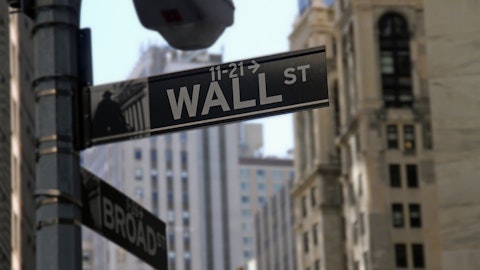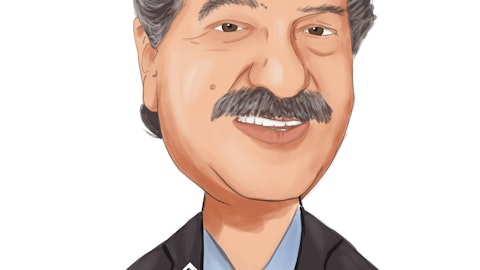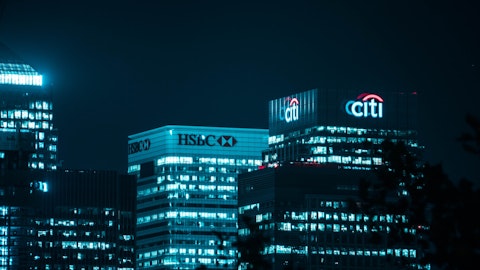Goldman Sachs BDC, Inc. (NYSE:GSBD) Q3 2023 Earnings Call Transcript November 8, 2023
Austin Neri: Good morning. This is Austin Neri, a member of the Investor Relations team for Goldman Sachs BDC, Inc., and I would like to welcome everyone to the Goldman Sachs BDC, Inc. Third Quarter 2023 Earnings Conference Call. Please note that all participants will be in listen-only mode until the end of the call and we will open up the line for questions. Before we begin today’s call, I would like to remind our listeners that today’s remarks may include forward-looking statements. These statements represent the Company’s belief regarding future events that by their nature are uncertain and outside of the Company’s control. The Company’s actual results and financial condition may differ, possibly materially from what is indicated in those forward-looking statements as a result of a number of factors, including those described from time to time in the Company’s SEC filings.

A finance executive with a satisfied smile reviewing a pile of documents in their office.
This audio cast, it is copyrighted material of Goldman Sachs BDC, Inc. and may not be duplicated reproduced or rebroadcast without our consent. Yesterday, after the market close, the Company issued an earnings press release and posted a supplemental earnings presentation, both of which can be found on the homepage of our website at www.goldmansachsbdc.com. under the Investor Resources section, and, which include reconciliations of non-GAAP measures to the most directly comparable GAAP measures. These documents should be reviewed in conjunction with the Company’s quarterly report on Form 10-Q filed yesterday with the SEC. This conference call is being recorded today, Wednesday, November 8, 2023, for replay purposes. I will now turn the call over to Alex Chi, Co-Chief Executive Officer of Goldman Sachs BDC, Inc.
Alex Chi: Thank you, Austin. Good morning, everyone, and thank you for joining us for our third quarter 2023 earnings conference call. I’m here today with David Miller, our Co-Chief Executive Officer; Tucker Greene, our Chief Operating Officer; and David Pessah, our Chief Financial Officer. I’ll begin the call by providing a brief overview of our third quarter results, before discussing the current market environment in more detail. I’ll then turn the call over to David Miller and Tucker Greene to describe our portfolio activity and performance, before handing it off to David Pessah to take us through our financial results, and then finally, we’ll open the line for Q&A. So with that let’s get to our third quarter results. Our net investment income per share for the quarter was $0.67, an increase of 13.6% over the prior quarter’s $0.59.
Excluding the impact of asset acquisition accounting, in connection with the merger with MMLC, adjusted net investment income for the quarter was $0.64 per share, equating to an annualized net investment income yield on book value of 17.5%. The increase in investment income during the quarter was primarily driven by an increase in repayments and related accretion of discounted positions. As we announced after the market closed yesterday, our Board declared a $0.45 per share dividend payable to shareholders of record as of December 29, 2023. This marks the Company’s 35th consecutive quarter of a $0.45 per share dividend, totaling $15.75 per share, since our IPO, excluding the special dividends we paid in 2021 post the merger with MMLC. Net asset value per share increased to $14.61 as of September 30, 2023, an increase of $0.02 from the end of the prior quarter.
This was primarily attributable to the increase of net investment income, which was partially offset by an increase in unrealized losses for the quarter. On a fair value basis, first lien loans are 94.9% of the investment portfolio as of September 30, 2023, which speaks to our continued focus on maintaining a higher-quality portfolio. Again this quarter, we continue to invest only in directly originated first lien senior secured debt with no participation in the secondary market for broadly syndicated loans. As our portfolio continues to evolve, we believe it’s particularly important to proceed with an abundance of caution with new underwritings, as the economic cycle evolves over the next few quarters, while base interest rates are expected to remain higher for longer.
We’ve previously expressed confidence that deal volumes will increase as the year progresses. During the third quarter, we reviewed more than 150 investment opportunities across our Direct Lending Americas Platform, which is sizably more than the opportunity seen to start the year. Although recent macroeconomic and geopolitical headlines may delay the timing of current deal closings by a quarter or so, we believe our existing pipeline of new opportunities remains extremely robust and we expect that 2024 will be an active year for private credit across the spectrum. Of note this quarter, GSBD was the lead lender in the refinancing of Rubrik, one of the first investments we made post-integration of the BDC platform with the broader Goldman Sachs private credit complex.
Rubrik is a provider of data backup and recovery software for enterprise customers and is an existing GSBD borrower. The latest transaction also involve the partial financing of an acquisition, which keeps the company’s pro forma capital structure at a very attractive loan-to-value. RV Media is another example of a new origination in the third quarter, where the Goldman Sachs private credit platform was the lead lender and GSBD was able to participate in financing the buyout of the business by a new financial sponsor. GSBD stands to benefit from deploying into more favorable vintage and high-quality credits and where we are an incumbent. Not only we’re setting economics to current market pricing but setting covenants and documentation to align with our orientation towards downside risk management.
With that let me turn it over to my Co-CEO, David Miller.
David Miller: Thanks, Alex. During the quarter, we originated $168.2 million in new investments and commitments to eight new and five existing portfolio companies. Sales and repayment activity totaled $257.4 million, primarily driven by the full repayment and exit of investments in seven portfolio companies. In particular, we are pleased with the full repayment of three junior lien positions, which will allow us to continue redeploying capital in new first lien-oriented opportunities, while remaining well within our leverage targets. Turning to portfolio composition, as of September 30, 2023, total investments in our portfolio were $3.4 billion at fair value, comprised of 97.5% senior secured loans including 91.3% in first-lien, 3.6% in first lien last-out unit tranche and 2.6% in second lien debt, as well as a negligible amount in unsecured debt, and 2.2% in a combination of preferred and common stock and warrants.
As of quarter end, the company held investments in 137 portfolio companies, operating across 38 different industries. The weighted average yield of our investment portfolio at cost at the end of Q3 was 11.6% [technical difficulty] amortized cost remained at 12.6% at the end of Q3. I will now turn the call over to Tucker Greene, to discuss our overall credit quality.
Tucker Greene: Thank you, David. The weighted average net debt to EBITDA of the companies in our investment portfolio remained flat at 5.9 times in the second quarter. Importantly, our portfolio companies had both top-line and EBITDA growth year-over-year on a weighted average basis. The weighted average interest coverage of the companies in our investment portfolio at quarter end declined slightly, from 1.56 times to 1.51 times as SOFR rates continue to increase for the quarter. It is important to note that we calculate our coverage ratios based on current quarter metrics, rather than on a trailing or last 12-month basis. Were we to use the LTM calculation, then, our interest coverage ratio of the companies in our investment portfolio would be 1.7 times.
We continue to monitor interest coverage sensitivity. The quarterly increase in SOFR is slowing and the Fed held rate flat, which creates more stability. We also see our interest coverage levels as a reflection of legacy’s vintage exposure within the book that will continue to be supported with repayment activity and new deployment in the current environment. And finally, turning to asset quality. As of September 30, 2023, two new positions were placed on non-accrual and one portfolio company was removed from non-accrual during Q3. Investments on non-accrual status amounted to 2.3% and 4.2% of the total investment portfolio at fair value and amortized cost respectively. Subsequent to quarter-end, one additional name was placed on non-accrual status.
The size of this position does not constitute a meaningful change to the percentage stated above. I will now turn the call over to David Pessah to walk through our financial results.
David Pessah: Thank you, Tucker. We ended the third quarter of 2023 with total portfolio investments at fair value of $3.4 billion, outstanding debt of $1.9 billion, and net assets of $1.6 billion. Our ending net debt to equity ratio as of the end of Q3 was 1.13 times, which continues to be below our target leverage range of 1.25 times. At quarter end, approximately 46% of the company’s total principal amount of debt outstanding was in unsecured debt and had $671 million of capacity available under our secured revolving credit facility. Subsequent to quarter end, we executed an extension to the maturity of our secured revolving credit facility from May 2027 to October 2028. As a reminder, we have two separate unsecured notes due in February of 2025 and January of 2026, respectively.
We plan to address these maturities at the appropriate time. Before continuing to the income statement, as a reminder, in addition to GAAP financial measures, we also reference certain non-GAAP or adjusted measures. This is intended to make the company’s financial results easier to compare to results prior to October 2020 merger with MMLC. These non-GAAP measures removed the purchase discount amortization impact from our financial results. For Q3, GAAP and adjusted after-tax net investment income were $72.9 million and $69.7 million, respectively, as compared to $64.5 million and $63.1 million respectively in the prior quarter. The increase in net investment income was primarily driven by repayment-related activity that was discussed earlier.
On a per share basis, GAAP net investment income was $0.67 and adjusted net investment income was $0.64, as compared to $0.59 and $0.58, respectively last quarter. Distributions during the quarter remained consistent at $0.45 per share. Our spillover taxable income is approximately $124.3 million or $1.13 on a per share basis, which we believe provides continued stability on our consistent dividend since inception. Net asset value per share, on September 30, 2023 was $14.61 as compared to $14.59 last quarter. With that, I’ll turn it back to Alex for closing remarks.
Alex Chi: Thanks, David. As you all are probably aware, on September 7, we announced that David tendered his resignation from his position at the Company, effective November 10 to pursue a new professional opportunity. At September 25, the Board appointed Stanley Matuszewski as our CFO and Treasurer, effective immediately upon David’s resignation on November 10. Stan has been at Goldman Sachs since 2013 and has been managing the product controllers team for our entire BDC platform. I want to congratulate and welcome Stan to our management team and wish, David, all the best for the future. In conclusion, thank you all for joining us on our call. With that, let’s open the line for Q&A.
Operator: [Operator Instructions] And our first question will come from Maxwell Fritscher with Truist Securities.
See also Top 11 Extreme Value Stocks To Buy and Top 20 Drug Companies in the US by Revenue.
Q&A Session
Follow Goldman Sachs Bdc Inc. (NYSE:GSBD)
Follow Goldman Sachs Bdc Inc. (NYSE:GSBD)
Maxwell Fritscher: Hi, good morning. I’m calling in for Mark Hughes, and I joined a little late, so I’m sorry if you mentioned this, but can you touch on spreads you’re seeing currently? Couple of other BDCs have mentioned a contraction in the quarter.
Alex Chi: Hi, good morning. Thanks a lot for the question. So we certainly saw a bit of further spread compression in the quarter – in the prior quarters, I think the average spread that we were seeing was well into the 600s, probably the mid-600s on average. We’ve seen some spread compression now, where more of the kind of standard rate for the middle of the fairway credit is more like 600 basis points, plus or minus. For some of the larger credits you might see a bit more spread compression, and for some of the more middle market credits you might see a little bit wider, but it’s around 600 is what we’re seeing.
Maxwell Fritscher: Okay, thank you. And could you provide a figure for the percentage of your portfolio companies that are below 1 times interest coverage ratio?
Alex Chi: It’s a – we haven’t disclosed that in the past, but it’s a very small percentage, single-digit percentage.
Maxwell Fritscher: Okay. Thank you.
Operator: Thank you. And our next question will come from Sean-Paul Adams with Raymond James.
Sean-Paul Adams: Hi guys, good morning. Quick question. I know you guys talked a little bit about the second lien book. I know you said you had some junior lien positions that exited. What’s the status of the remainder of your second lien book, and what are you guys seeing on the pipeline?
Alex Chi: Yes, I mean, from a pipeline perspective, it’s not something we’re actively pursuing. We look at them from time-to-time, but it’s not the focus where we’re expanding. I think, as we said in our prepared comments, our first lien book is right around 95%. So the legacy book continues to run down and is a very small percentage of the overall portfolio today.
Sean-Paul Adams: Excellent. Thank you. And I didn’t notice if you said the two new non-accruals, which companies were those?
Alex Chi: Thrasio and Zodiac.
Sean-Paul Adams: Got you. Thank you. As far as Thrasio, has there been any communication between the sponsor, as far a, you know…
Alex Chi: Yes, so we’re in active discussions amongst the lender group with the sponsors behind the company. It’s a relatively sizable group of lenders that are in the club. So we’re in active discussions. This is a relatively sizable position for us. Thrasio is, as you might know, it’s a market leader in the online ecosystem, where many of the players in that ecosystem are experiencing some issues. And we wouldn’t be surprised if consolidation is a likely outcome, but more to come on that.
Sean-Paul Adams: Got it. Thank you.
Operator: [Operator Instructions] We’ll take our next question from Derek Hewett with Bank of America.
Derek Hewett: Good morning, everyone. Most of my questions were already asked and answered, but could you – from a modeling perspective, could you talk a little bit about what was the impact of the look back on Q3 results? How much on a per share basis was that? Thank you.
Alex Chi: Thanks for the question. This is the last of the 2020 look back from COVID impact. It was roughly – it was about $0.04 of cap to the per share calculation itself. That was removed because of the look back.
Derek Hewett: Okay. Okay, great. Thank you.
Alex Chi: Thank you.
Operator: That concludes today’s question and answer session. Mr. Chi, at this time, I will turn the conference back to you for any additional or closing remarks.
Alex Chi: Thanks, everyone, for joining our call. We appreciate the interest and support, and we look forward to closing the year. Thank you very much.
David Miller: Thank you.
Operator: This concludes today’s call. Thank you for your participation. You may now disconnect.



